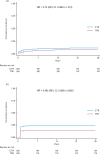Continuous positive airway pressure to prevent reintubation in patients recovering from cardiac surgery: A multicentre randomised clinical trial
- PMID: 40574561
- PMCID: PMC12517714
- DOI: 10.1097/EJA.0000000000002229
Continuous positive airway pressure to prevent reintubation in patients recovering from cardiac surgery: A multicentre randomised clinical trial
Abstract
Background: Pulmonary complications, including atelectasis and reintubation, are common after cardiac surgery and are associated with increased morbidity and mortality. Postoperative continuous positive airway pressure (CPAP) may reduce these risks, but its effectiveness remains uncertain.
Objectives: To assess whether CPAP reduces the need for reintubation in hypoxaemic patients after cardiac surgery, and to evaluate its effect on other postoperative pulmonary complications.
Design: Multicentre, open-label, randomised clinical trial. The study was prematurely terminated due to funding constraints, leading to an underpowered sample.
Setting: Ten university-affiliated hospitals across Italy.
Patients: Adults undergoing cardiac surgery with cardiopulmonary bypass who developed a Pa O 2 /FiO 2 ratio 200 or less within 1 h of extubation. Exclusion criteria included severe COPD, previous mechanical ventilation and lack of consent.
Main outcome measures: The primary endpoint was reintubation within 28 days of surgery. Secondary endpoints included atelectasis, pneumonia, sepsis, mortality and oxygenation.
Results: The incidence of reintubation was 10.8% (95% confidence interval [CI], 6.52 to 15.15) in the control group and 8.3% (95% CI, 4.51 to 12.16) in the treatment group ( P = 0.3908). In contrast, the occurrence of atelectasis was significantly higher in the control group at 24.1% (95% CI, 18.20 to 30.07) compared with 14.2% (95% CI, 9.38 to 19.05) in the treatment group ( P = 0.0110). At 48 h, the incidence of reintubation was significantly lower in the CPAP group 2.94% (95% CI, 0.60 to 5.28) compared with the control group, 7.39% (95% CI, 3.76 to 11.02), P = 0.0425. No significant differences in pneumonia, sepsis or mortality were observed. CPAP significantly improved oxygenation ( P < 0.0001).
Conclusion: CPAP did not significantly reduce 28-day reintubation rates compared with oxygen therapy via Venturi mask. However, CPAP was associated with a significant reduction in atelectasis and early reintubation at 48 h. Further research is warranted to confirm these findings and compare CPAP with other noninvasive support strategies.
Trial registration: ClinicalTrials.gov Identifier: NCT01726140.
Copyright © 2025 The Author(s). Published by Wolters Kluwer Health, Inc. on behalf of the European Society of Anaesthesiology and Intensive Care.
Conflict of interest statement
Conflicts of interest: none.
Figures
References
-
- Pereira SM, Tucci MR, Morais CCA, et al. Individual positive end-expiratory pressure settings optimize intraoperative mechanical ventilation and reduce postoperative atelectasis. Anesthesiology 2018; 129:1070–1081. - PubMed
-
- Rothen HU, Sporre B, Engberg G, et al. Airway closure, atelectasis and gas exchange during general anaesthesia. Br J Anaesth 1998; 81:681–686. - PubMed
-
- Tokics L, Hedenstierna G, Strandberg A, et al. Lung collapse and gas exchange during general anesthesia: effects of spontaneous breathing, muscle paralysis, and positive end-expiratory pressure. Anesthesiology 1987; 66:157–167. - PubMed
Publication types
MeSH terms
Associated data
LinkOut - more resources
Full Text Sources
Medical





